Wandering through the streets of Thebes, I feel the past whispering around me, its soft voices shaping the world we know today. Time seems to blend smoothly here, weaving together the ancient and the modern into a single fabric. This city, once a giant in the Greek world, is vibrantly alive, each stone and path narrating its own story and humming its own melody. Thebes, with its rich myths and modern details, both charms and teaches us in its own unique way.
Thebes Key Facts
| Name | Thebes |
| Main Deities/Myths | Zeus; Heracles; Oedipus |
| Key Legends | Birthplace of Heracles; The Tragedy of Oedipus; Dionysian Rites |
| Accessibility | Accessible via a one-hour drive from Athens; central mainland Greece |
| Estimated Visit Duration | Full day for an immersive experience |
Overview
Thebes, the flame of antiquity, is a city wrapped in history and myth. It was founded by Cadmus, a legendary figure from ancient tales. Cadmus was the son of either Phoenix or Agenor, who was the King of Phoenicia. Cadmus had a sister named Europa. Zeus, the king of the gods, took Europa away. Cadmus, her brother, searched everywhere but couldn’t find her. Feeling upset and unsuccessful, he asked the Delphic oracle for help.
The oracle told him to stop looking for Europa, follow a cow instead, and build a town where the cow rested. He followed these instructions, and the cow led him to Boeotia, meaning “Cow Land.” There, he founded the city of Thebes, marking the start of this famous city in central Greece.
The story of Cadmus and the founding of Thebes in Greek mythology is full of interesting ideas. It shows how fate, or destiny, plays a big role in our lives. Cadmus’s journey wasn’t just something he chose; it was part of a bigger plan that he couldn’t change. In this myth, Cadmus’s journey shifts from a desperate quest to a journey of creation. When he follows the oracle’s guidance to build a city where the cow lies down, it symbolises the start of a new chapter, rising from the ashes of his previous anguish. This act of founding Thebes becomes a tribute to the sister he couldn’t find, honouring her memory not in continued sorrow, but in the birth of a great civilization.
In essence, the story of Cadmus is about embracing change not just as an inevitable part of life, but as an opportunity to create something lasting and significant. It’s a tale of how human spirit and creativity can triumph over loss and despair, a theme that is common in Greek mythology.
Thebes in Greek Mythology
Thebes’ legends are closely tied to the stories of its royal family, who were descendants of Cadmus. This family had a mix of blessings and tragic fates, and they were really important in the city’s mythical past. Their stories are full of adventures, challenges, and sometimes sad endings, showing how gods and humans interacted in old times. These tales make Thebes a fascinating place with a rich history that’s a mix of real events and mythical stories. It’s like every corner in Thebes has a story to tell about this famous family and their impact on the city.
The Birth of Heracles
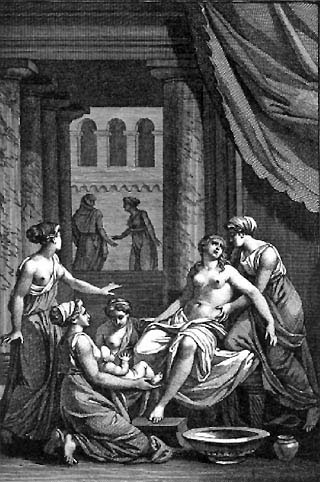
Thebes is also best known for being where Heracles (also known as Hercules) was born. Heracles was the son of Zeus, the king of the gods, and Alcmene, a mortal woman descended from the illustrious Perseus and connected to the lineage of Cadmus. Renowned for his extraordinary strength and valour, Heracles became a symbol of heroism and resilience.
His life in Thebes was marked by challenges from the outset, chiefly due to Hera, Zeus’s wife, who harboured a deep animosity towards him. Despite Hera’s relentless hostility, Heracles emerged as one of the greatest heroes in Greek mythology. His journey included the completion of the Twelve Labours, a series of formidable tasks that started in Thebes and took him across the known world, cementing his legendary status
Heracles had strong ties to Thebes, not just because he was born there. As an adult, he had both great victories and sad times in the city. He protected Thebes from different dangers, which made the people really thankful. But Hera, who never liked him, made him go mad sometimes, causing sad things that affected his life a lot. Heracles’ story in Thebes is all about being a hero, how the gods get involved in human lives, and trying to fight against what’s meant to be. This makes Thebes a really important place in the stories about this famous hero.
The Oedipus Saga
Gazing upon the immense and imposing walls of the city, originally constructed to defend against outside attacks, my thoughts wander to another legendary story from Thebes. Whenever I think of the city, the name Oedipus invariably comes to mind. The figure of Oedipus, a central character in Theban mythology and a descendant of the Cadmus lineage, is known for having one of the most poignant and tragic stories in Greek mythology.
The story of Oedipus unfurls with a chilling prophecy: he is destined to slay his father and wed his mother. This foreboding revelation terrifies his parents, the reigning monarchs of Thebes, prompting them to leave him to fate’s mercy as an infant. However, unknown to them, Oedipus does not perish but is raised in the distant land of Corinth.
As he matures, he learns of this ominous prophecy himself, which fills him with deep dread He departs from Corinth in an attempt to escape his fate, only to encounter it head-on. Oedipus rose to become the king of Thebes following his solution to the Sphinx’s complex riddle. His success brought about the Sphinx’s demise but also set the stage for his own tragic end.
It’s a tale deeply rooted in the relentless pursuit of truth, regardless of its potentially devastating consequences. His story intricately weaves themes of human destiny, the quest for self-understanding, and the gods’ influence over mortal lives. It raises questions about the extent of human agency in shaping one’s fate, delving into the complex interplay between predestined paths and personal choices.
The Riddle of the Sphinx
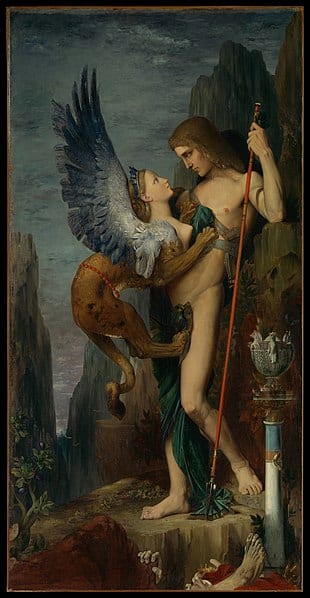
The Sphinx, the figure that Oedipus defeats, highlights the fascinating nature of Thebes, a city where people’s cleverness and courage faced incredible mystical challenges. This creature, with a woman’s head, a lion’s body, and eagle’s wings, was sent by the gods as a punishment. It gave the people of Thebes a riddle that was really hard to solve, and if they couldn’t answer it, the Sphinx would eat them. This caused a lot of fear and sadness in the city, as nobody seemed able to stop the Sphinx’s terror.
The riddle posed by the Sphinx, puzzled the minds of many: what creature walks on four legs in the morning, two at noon, and three in the evening? This riddle ingeniously encapsulated the journey of human life, from crawling as an infant, walking upright in adulthood, to relying on a cane in old age. The riddle remained unsolved, confounding all, until Oedipus, on his journey to Thebes, encountered the Sphinx.
His astute response, “a human,” not only spared his life from the immediate danger posed by the Sphinx but also liberated Thebes from her tyrannical reign. Overcome by Oedipus’ intellect, the Sphinx took her own life, thus ending the reign of terror she had inflicted. The unravelling of this riddle marked a pivotal moment for Thebes and for Oedipus himself, although he was unaware of its full implications. This critical achievement led to Oedipus ascending to the throne, inadvertently setting in motion a series of dramatic events in his life.
Amphion and Zethus
In the myths of Thebes, Zeus and Antiope’s twin sons, Amphion and Zethus, are really important. Their story has sadness, toughness, and in the end, success. Amphion was great at music and the arts, and Zethus was strong and athletic. They show how culture and strength can work together perfectly. The story goes that they were key in making Thebes strong. Amphion could magically move stones to build the city’s walls just by playing his lyre, and Zethus helped with his physical power.
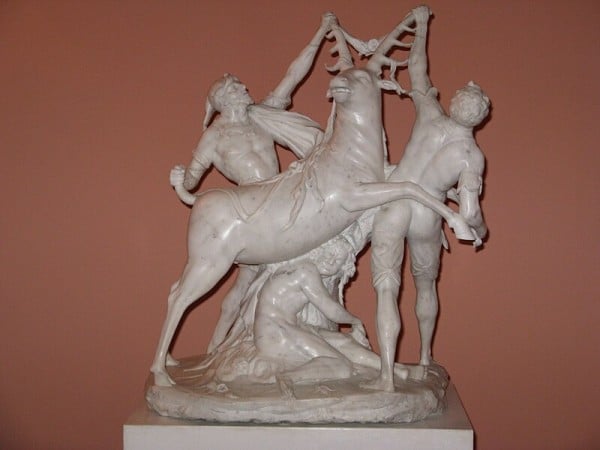
In Thebes, the shared tomb of Amphion and Zethus serves as a powerful symbol of their enduring legacy. It’s a tangible link to the city’s mythical roots, where artistic brilliance and physical strength were harmoniously united. While their story might not be as well-known as other Theban legends, understanding Amphion and Zethus is key to grasping the essence of Thebes. Their tale encapsulates the city’s dual character: a place renowned for its significant cultural contributions and its impressive strength. In Thebes, the lines between myth and history beautifully intertwine, reflecting the city’s rich and complex identity.
The Dionysian Rites
In the myths of Thebes, Zeus and Antiope’s twin sons, Amphion and Zethus, are really important. Their story has sadness, toughness, and in the end, success. Amphion was great at music and the arts, and Zethus was strong and athletic. They show how culture and strength can work together perfectly. The story goes that they were key in making Thebes strong. Amphion could magically move stones to build the city’s walls just by playing his lyre, and Zethus helped with his physical power.
In Thebes, the shared tomb of Amphion and Zethus serves as a powerful symbol of their enduring legacy. It’s a tangible link to the city’s mythical roots, where artistic brilliance and physical strength were harmoniously united. While their story might not be as well-known as other Theban legends, understanding Amphion and Zethus is key to grasping the essence of Thebes. Their tale encapsulates the city’s dual character: a place renowned for its significant cultural contributions and its impressive strength. In Thebes, the lines between myth and history beautifully intertwine, reflecting the city’s rich and complex identity.
This makes Thebes an essential destination for anyone captivated by the complex web of human history and the lasting fascination of ancient stories. Exploring Thebes today is a remarkable experience that combines ancient history with modern culture. The remains of its famous past exist alongside the vibrant life of today, making it feel like you are touching the past in the present. I’m about to share a list of some of the most enjoyable and amazing places in the city, along with a brief discussion about each. But before diving into that, it’s important to go over some practical tips.
Practical Tips
The best times to visit Thebes are in the spring and fall when the weather is mild and good for exploring. Even though it’s hot, summer has its own appeal and is when most tourists come. If you visit in the summer, get ready for the heat. It’s best to explore in the early morning or late afternoon to stay out of the strong midday sun. Additionally, carrying water, wearing sun protection, and dressing in light, breathable clothing can make your visit more comfortable. Remember to take regular breaks in shaded areas, and consider indoor activities, like visiting museums, during the hottest part of the day. These tips will help ensure a pleasant and safe experience in Thebes, regardless of the season.
Today’s Thebes, though not as magnificent as it was in ancient times, is an active city with a mix of old landmarks and modern comforts. Visitors will find a city that honours its history but also enjoys modern life. There are many things to do, from relaxing in small coffee shops to learning in interesting museums. Now, let’s explore the must-see destinations in Thebes, each of which deserves attention and discussion when visiting this historic city.
Sights to Explore in Thebes
The Cadmea
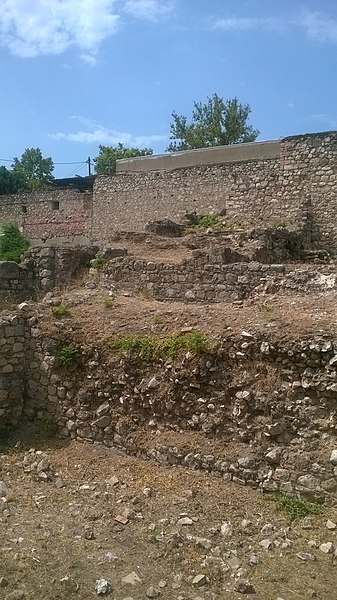
The Cadmea, an old fortress in the center of Thebes, is full of stories and history. It’s named after Cadmus. The Cadmea is an ancient, crumbling fortress located at the heart of Thebes, rich in fascinating stories. Today, what remains of the Cadmea are ruins, yet they hold a unique significance. Visitors stepping through these ruins are walking on the same ground once trodden by powerful kings and legendary heroes. This place is more than just a collection of old stones; it’s a historical site where important events took place, significantly shaping the legacy of Thebes and influencing the course of ancient Greek history.
Looking at this magnificent place with its wide views of the city today, it really makes me think about how history keeps repeating itself. The Cadmea has ruins from many different times, showing how the city was destroyed and rebuilt over and over. This tells us about the ups and downs Thebes has seen. As I walk among these ruins, I feel a strong link to the past and to the tales of power, dreams, and the ongoing struggles of people that these stones have seen.
Thebes Archaeological Museum
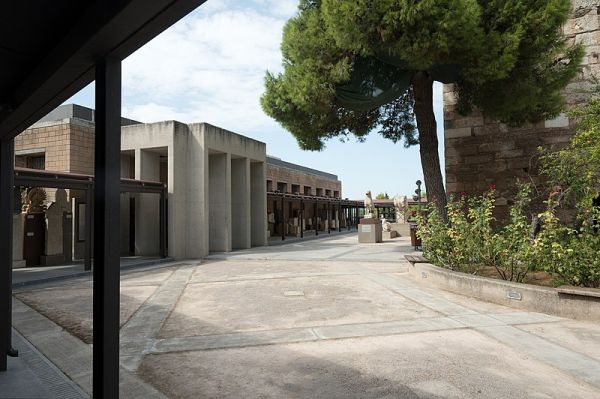
Visiting the Thebes Archaeological Museum is like walking into a storehouse full of history. The museum has a big collection of old items that show the city’s history, from its legendary start to when it was an important city in ancient Greece. You can see things like pots, statues, detailed jewellery, and weapons. These items tell the story of Thebes, showing what everyday life, religion, and art were like in the old city.
The museum, which started in 1905, is one of the oldest museums in Greece. It first opened in an old military building and has grown a lot since then to show all the cool stuff found in the area. In 2007, they made the museum bigger and better, and now it’s one of the best places to learn about Greek history. The museum takes you from the earliest times right up to the Ottoman era, with everything laid out in order. It’s got fun interactive stuff and easy explanations about different times and the things they found. It’s a great place to visit if you’re into the whole story of Greek history.
Walking through the Thebes Archaeological Museum feels like stepping through different doors into Theban life. Each exhibit is like a story, showing not just how great the city was, but also its connections with other old cultures. It’s like seeing Thebes in the big picture of Mediterranean history. Wandering around here, I feel like I’m time-traveling, getting up close with Thebes’ culture and history. It’s amazing to think about the people who made and used these things long ago. Visiting this museum is a must if you want to really get what Thebes was all about. It’s making me see the city in a whole new light!
The Amphitheatre
The Amphitheatre in Thebes, even though it’s a bit marked by its age, really shows the city’s amazing culture from the past. This is where people used to come together to watch plays and big gatherings. It’s still really important to Thebes today. When you’re standing in the middle of the amphitheatre, it’s like you can almost hear the actors from long ago and the sounds of the crowd. It makes you feel like you are part of the busy cultural and social life of old Thebes. Like many ancient Greek amphitheatres, the site in Thebes offers a direct link to the past and is used for modern performances, providing audiences with an authentic experience of ancient Greek theatre settings.
The myths and stories from Thebes, which might have been shown in plays in its amphitheater, added a lot to Greek drama. Plays about Thebes or with characters from Thebes, like the ones Sophocles wrote, must have been really special to see right there. It’s like watching a story unfold in the place where it’s actually set.
The amphitheatre today however is more than just a historical landmark. It stands as a symbol of the lasting impact of Greek theatre on Western culture. When people visit the amphitheatre, they can think about the big themes in ancient Greek plays – like destiny, fairness, and human experiences – that are still relevant today. This place lets you do more than just see history; you can really feel it. It’s like a link between the old and the new, showing us how art and storytelling are always important, no matter the era.
Chamber Tombs of Oedipus’ Children
In Thebes, a significant discovery is the chamber tombs. They are believed to be related to the heart-wrenching story of Oedipus and his family, a tale that has captivated and saddened generations of thinkers. Found in the Kastellia cemetery, these tombs go back to the 13th century BC and are adorned with striking murals depicting scenes of grief and honor. Moreover, their grand scale and artistic detail suggest they were meant for people of high status.
Legend has it that these tombs were for Eteocles and Polynices. The two sons of Oedipus, who tragically killed each other in the ‘Seven Against Thebes’ battle. Being some of the largest Mycenaean chamber tombs ever uncovered, they provide a powerful link to the tragic legacy of Oedipus, a story deeply rooted in Greek mythology.
Temple of Ismenius Apollo
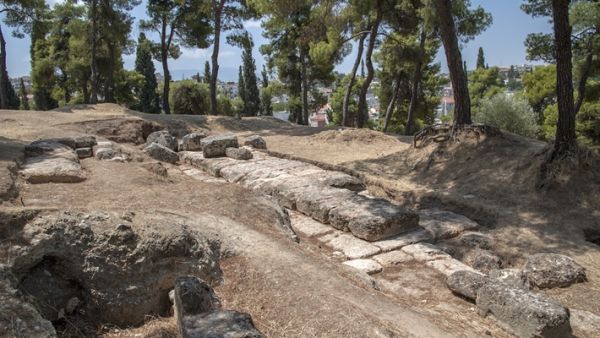
The sanctuary of Ismenios Apollo in Thebes is a really interesting spot. It’s up on a hill that’s been special since around 1500 BC. They built this temple for Apollo, the god of prophecy, music, and arts. Over time, they rebuilt it a few times. The first one was put up near the end of the 8th century BC, and then they made a new one in the old Doric style. This one was around until the early 4th century BC. After that, they started another Doric temple, but it seems like they didn’t finish it.
Nowadays, when you go there, you can see what’s left of the last temple’s base. It really gives you a feel for Thebes’ religious past and how much they respected Apollo. Seeing the temple makes you realize how important Thebes has been for a long time in terms of religion. It’s kind of amazing to stand there and think about all the history that happened right where you are. The Temple of Ismenius Apollo is like a link to the city’s deep spiritual roots and its role in Greek religious history.
Nearby Attractions
1. Delphi
Traveling from Thebes to Delphi is like stepping back in time to the core of ancient Greek spirituality and mysticism. Delphi, home to the famed Oracle, was more than a religious site; it was the epicentre of the ancient Greek world. Here, the enigmatic priestess Pythia delivered her cryptic prophecies, guiding the destinies of both commoners and kings. Visiting Delphi today, you’re not just seeing ancient ruins; you’re entering a realm where divine secrets were once unravelled, and humanity’s thirst for understanding and guidance found its most sacred expression. This journey isn’t just geographical; it’s a voyage into the heart of ancient wisdom and the mysteries that have captivated human imagination for millennia.
2. Mount Helicon
Nestled near Thebes lies Mount Helicon, a location steeped in myth and legend. It also famously regarded as the dwelling of the Muses. In ancient Greece, this mountain was not just a geographical landmark. It was also a wellspring of creative inspiration, revered by poets and artists. Its majestic presence and mythological connections have made it a timeless muse. It continues to ignite the imaginations of visitors even in the modern era. The allure of Mount Helicon transcends mere scenery. It’s a symbol of artistic inspiration and a testament to the enduring power of ancient myths in inspiring contemporary creativity.
Last Thoughts on Thebes
Walking down the streets of Thebes, I am enveloped by a wind that seems so alive with history and myth. The air is rich with the essence of a civilization that cradled human creativity. Moreover, it was here that the earliest seeds of art, literature, and wisdom were sown. With each step, I feel moved by the thought that these very streets were among the first to witness the dawn of human civilization. It’s a place where the echoes of the past resonate. However, its legacy is shaping the world we know today in ways both subtle and profound. Thebes, with its ancient stones and timeless tales, is not just a city; it’s a living testament to the enduring legacy of human endeavour.
As I leave Thebes, heading either back home or deeper into Greece, I take with me unforgettable memories of a city where history and myths coil together. The stories of Thebes, rich and inspiring, encourage me to explore more of this ancient land’s heritage. This city, with its aged stones and timeless tales, is a powerful reminder of the relentless spirit and achievements of humanity.
Featured Image Credit: Michal Jančina, Public domain, via Wikimedia Commons
